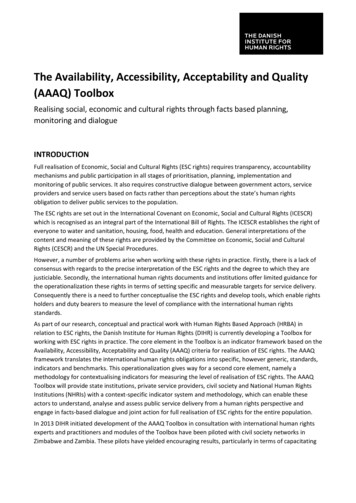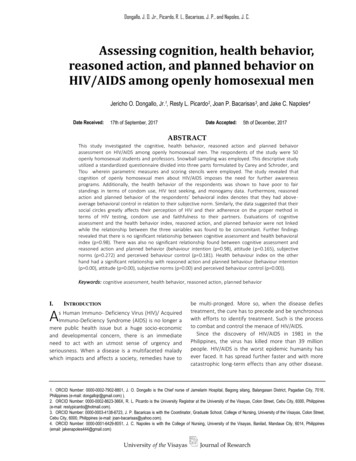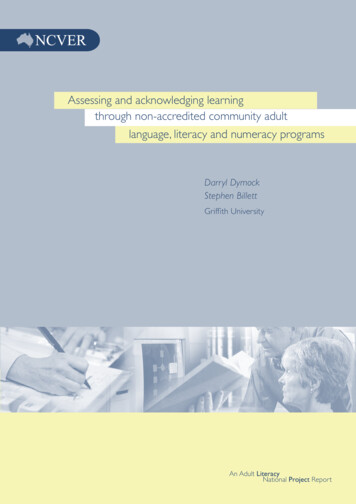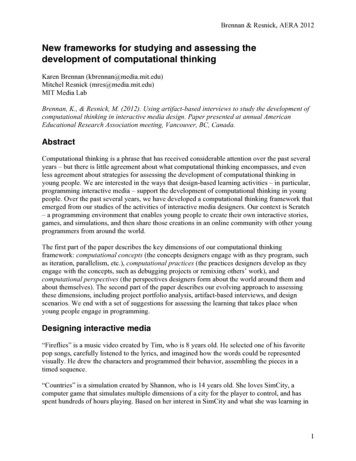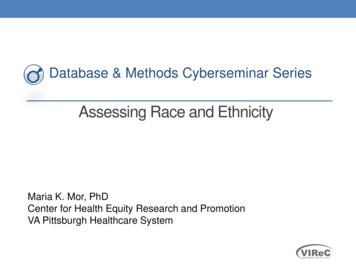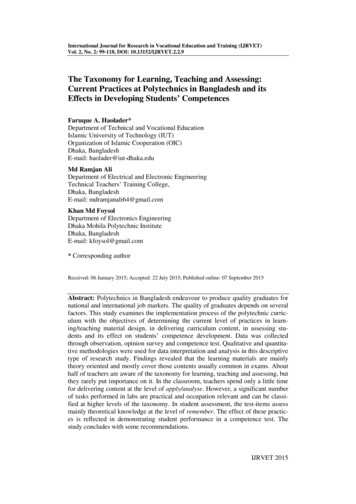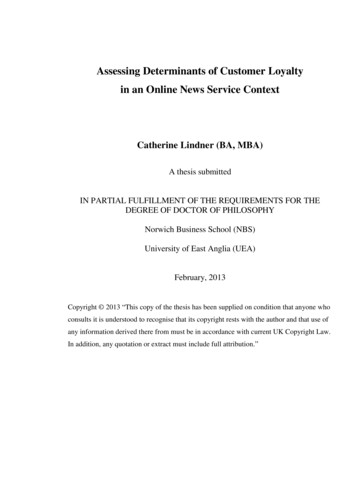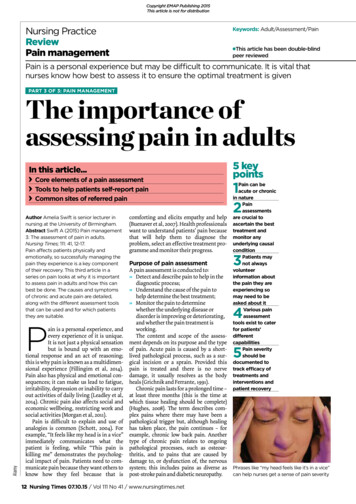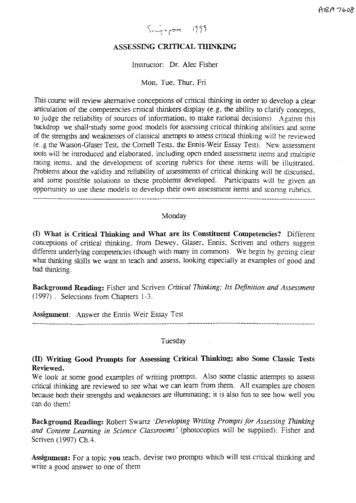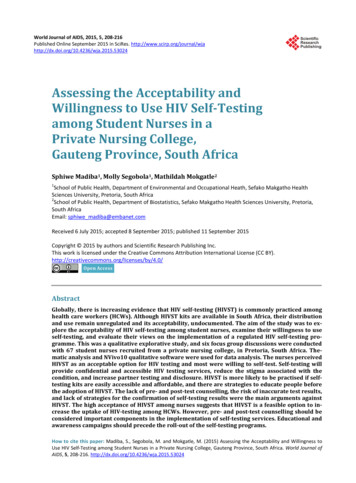
Transcription
World Journal of AIDS, 2015, 5, 208-216Published Online September 2015 in SciRes. 10.4236/wja.2015.53024Assessing the Acceptability andWillingness to Use HIV Self-Testingamong Student Nurses in aPrivate Nursing College,Gauteng Province, South AfricaSphiwe Madiba1, Molly Segobola1, Mathildah Mokgatle21School of Public Health, Department of Environmental and Occupational Heath, Sefako Makgatho HealthSciences University, Pretoria, South Africa2School of Public Health, Department of Biostatistics, Sefako Makgatho Health Sciences University, Pretoria,South AfricaEmail: sphiwe madiba@embanet.comReceived 6 July 2015; accepted 8 September 2015; published 11 September 2015Copyright 2015 by authors and Scientific Research Publishing Inc.This work is licensed under the Creative Commons Attribution International License (CC tractGlobally, there is increasing evidence that HIV self-testing (HIVST) is commonly practiced amonghealth care workers (HCWs). Although HIVST kits are available in South Africa, their distributionand use remain unregulated and its acceptability, undocumented. The aim of the study was to explore the acceptability of HIV self-testing among student nurses, examine their willingness to useself-testing, and evaluate their views on the implementation of a regulated HIV self-testing programme. This was a qualitative explorative study, and six focus group discussions were conductedwith 67 student nurses recruited from a private nursing college, in Pretoria, South Africa. Thematic analysis and NVivo10 qualitative software were used for data analysis. The nurses perceivedHIVST as an acceptable option for HIV testing and most were willing to self-test. Self-testing willprovide confidential and accessible HIV testing services, reduce the stigma associated with thecondition, and increase partner testing and disclosure. HIVST is more likely to be practised if selftesting kits are easily accessible and affordable, and there are strategies to educate people beforethe adoption of HIVST. The lack of pre- and post-test counselling, the risk of inaccurate test results,and lack of strategies for the confirmation of self-testing results were the main arguments againstHIVST. The high acceptance of HIVST among nurses suggests that HIVST is a feasible option to increase the uptake of HIV-testing among HCWs. However, pre- and post-test counselling should beconsidered important components in the implementation of self-testing services. Educational andawareness campaigns should precede the roll-out of the self-testing programs.How to cite this paper: Madiba, S., Segobola, M. and Mokgatle, M. (2015) Assessing the Acceptability and Willingness toUse HIV Self-Testing among Student Nurses in a Private Nursing College, Gauteng Province, South Africa. World Journal ofAIDS, 5, 208-216. http://dx.doi.org/10.4236/wja.2015.53024
S. Madiba et al.KeywordsHIV Self-Testing, Nurses, Acceptability, South Africa, Health Care Workers1. IntroductionSouth Africa adopted provider-initiated HIV testing and counselling (PITC) as a possible strategy for expandingHIV testing in health facilities. In PITC, health providers offer HIV testing to all patients or clients accessinghealth facilities irrespective of their presenting medical problems [1]. The PITC approach makes HIV testingand counselling (HCT) part of the routine services offered in a health facility, and in South Africa, PITC addressessome health system barriers to testing such as the availability of counsellors and counselling rooms [2]. An evaluation of the PITC approach showed an increased uptake of HIV testing among clients offered PITC comparedwith referrals to voluntary counselling and testing sites [3]. Although access to and uptake of HCT has increasedsignificantly following the implementation of PICT, many people, including many of those at high risk, still donot know their status [4]-[6]. While PITC is an effective public health intervention to increase access to HCT, itcannot be the only solution to expanding HIV testing because of challenges that limit its impact and scope [2].Health care workers (HCWs) are particularly vulnerable to acquiring HIV; they are vulnerable to HIV infection through sexual exposure in their personal lives and face an added risk of occupational exposure to HIV infection [7] [8]. Despite the high risk of HIV infection, many HCWs are reluctant to seek HIV testing, especiallyin facilities where their co-workers could access their results. They have concerns about the lack of privacywhen testing in their health facilities. They also fear that their co-workers would know their HIV status and theymay experience stigma from their colleagues [9] [10]. The act of having an HIV test can be stigmatizing, asHCWs are often assumed to be HIV-positive if they are known to have tested [11]. Given the level of stigmathat exists around HIV and fear of others finding out about their HIV status, HCWs need an option that wouldallow them to test privately and anonymously [9], and HIV self-testing (HIVST) could be a more discrete approach for HWCs to find out their HIV status [6].HIVST refers to conducting of an HIV test on oneself, and can be performed using home sample collectionkits or home self-testing [12]. The test is collected, performed, and interpreted in private by the individual whowants to know about their HIV status. HIVST have the potential for early identification of HIV-infected individuals in order to facilitate timely treatment initiation [6]. HIVST can be an alternative to PITC because it isone of the options that promise confidentiality and privacy of test results [7] [12]. Therefore, providing HIVSTfor HCWs would increase access to HIV testing in an environment that is private, not threatening, and withoutanxiety about stigma from colleagues [9]. According to the World Health Organization (WHO), HIVST kits arecurrently being used in various settings, and may be useful for HCWs in settings in which HIV is prevalent [6].Globally, there is increasing evidence that HIVST is commonly practiced among HCWs. A study conductedacross five African countries found self-testing to be acceptable to be practiced by HCWs. Furthermore, advocacy for self-testing is becoming more common, and some national policies now support regulated self-testing[10]. However, due to the limited experience with self-testing, it is not yet known whether increasing access toHIVST for HCWs through regulated self-testing will lead to a greater uptake of HIV prevention services [4].There is a need to assess the feasibility, acceptability, and uptake of a regulated programme of self-testingamong HCWs [4]. The need for baseline data on HIVST was the impetus for this study, largely because although HIV self-tests are available in South Africa, their distribution and use remains unregulated [2]. The aimof the study was to explore the acceptability of HIV self-testing among student nurses, examine their willingnessto use self-testing, and their views on the implementation of a regulated HIV self-testing programme. We feltthat student nurses were a relevant group of HCWs to inform the feasibility and acceptability of HIVST. Whilethey are classified as HCWs and face challenges of testing in health care facilities where their privacy may becompromised, they are also young and at high risk for HIV transmission.2. Methods and Materials2.1. Study DesignThe study was qualitative in nature, using focus group discussions. A convenience sample of 67 student nurses209
S. Madiba et al.was recruited from a private nursing college in Gauteng province, South Africa. The college trains auxiliarynurses, offers bridging of auxiliary nurses to enrolled nurses, enrolled nurses to professional nurses, and postgraduate training for critical care, operating theatres, and orthopaedic nursing. All nurses who were on block atthe college during the time of data collection were able to inform the objectives of the study, hence the use ofconvenience sampling.2.2. Data CollectionFive focus group discussions were conducted using a semi-structured guide with open-ended questions andprobes. The focus group guide outlined general questions about knowledge, acceptability, benefits, and disadvantages of self-testing. Participants were also asked about their willingness to use self-testing as well as theirviews on how it should be implemented. The focus groups were audio-recorded with the permission of the participants and lasted for about 60 minutes. The discussions were conducted by the second author with the assistance of a research assistant trained in qualitative research methods. Demographic data were collected at the endof the focus group discussions.2.3. Data AnalysisThematic analysis was used for data analysis. Focus group discussions were transcribed verbatim and thencompared to the original recording to ensure accuracy. The authors performed multiple readings of some of thetranscripts to identify initial codes and develop a code list consisting of common themes emerging from the data.Once consensus was reached on the definitions of themes, the transcripts were imported into NVivo version 10,a qualitative analysis software package for application of codes on the transcripts. The transcripts were recodedif a new code emerged or an existing code was revised.Trustworthiness was ensured through various strategies. A digital audio recorder was used to facilitate verbatim transcription and ensure that the findings reflect the views and perceptions of the participants. Data weretriangulated by collecting focus group discussions, writing of extensive field notes and interview notes, and collecting demographic data from the participants. The authors also held peer debriefing sessions to identify codesemerging from the data. NVivo 10 computer software for qualitative data analysis was used to aid data organisation and analysis [13].2.4. Ethical ConsiderationsEthical approval was obtained from the Medunsa Research Ethics Committee (MREC) of the University ofLimpopo (MREC/H/50/2013: PG). Permission to conduct the study was obtained from the Research Committeeof the Nursing College and the campus principal. All participants provided informed consent after the study wasexplained and assured of confidentiality and anonymity.3. Results3.1. Description of Study SampleThe sample consisted of 67 student nurses who participated in five focus group discussions. Almost all (n 65,97%) were females and were aged 19 - 55 years with a mean age of 28.9 years. With regards to their qualifications, 32 (55.1%) were nursing assistants and 25 (44.9%) were enrolled nurses, 7 (10.4%) were nurses on training, and only one was a professional nurse. Over half (n 34, 56%) reported that they treat HIV positive patients regularly, 12 (18%) treat HIV-positive patients only when required to do so, and 19 (29.7%) were not involved in the treatment of HIV positive clients. Almost all (n 65, 98.5%) had previously tested for HIV, half(n 31, 50.8%) tested at primary health clinics, a third (n 18, 29.5%) tested at the hospital, and the rest testedat school, laboratory, and doctor’s rooms. A quarter (n 15, 25%) said the quality of HIV counselling they received was excellent, 26 (43.3%) said it was good, 6 (10%) said it was poor, and 13 (21.7%) did not give anopinion.3.2. ThemesAnalysis of the focus group discussions revealed five themes: 1) acceptability of HIV self-testing; 2) non-ac-210
S. Madiba et al.ceptability of self-testing; 3) willingness to adopt HIV self-testing; 4) recommendations for uptake of self-testing; 5) linking self-testing to health facilities. Seven subthemes emerged from acceptability of self-testing andtwo subthemes emerged from non-acceptability of self-testing (Table 1).3.2.1. Acceptability of HIV Self-TestingThe success of the self-testing program is dependent upon the acceptability and willingness of people using thattest. For most participants, HIVST was acceptable as an alternative testing option. A number of subthemes thatsupport acceptability of HIVST emerged from the data and are outlined below.1) HIV Self-Testing Is GoodParticipants viewed HIVST as acceptable because it allows the user to decide who should be informed about thetest results. They felt that HIVST will provide confidentiality for individuals who desire more privacy:I think self-testing is good for people who are scared to go to the clinic, due to stigma and the attitudes of thenurses, so I think it will help people who are afraid (participant FG 3).I think it’s a good idea, people don’t know their status because of stigma, if you do the self-testing then it’s theway to go, people don’t like clinics, especially males, so with the self-testing it’s going to be the best thing (participant FG 2).2) HIV Self-Testing Is AccessibleThe participants were of the view that people do not test because HIV testing facilities are far. They felt thatHIVST will be accessible because the user can test anytime in the convenience of their home:The benefit is that it will be accessible and then you will be able to do it at any time, at any point of your life(participant FG1).It will be accessible, even if you meet a partner or a new boyfriend, you can always test first before you dothings, and I personally think it’s a good idea (participant FG 3).3) Confidentiality and Privacy Are EnsuredPerceived lack of privacy and confidentiality in public HIV testing centres is associated with poor uptake of HIVtesting. HIVST is an acceptable option because it will offer privacy and confidentiality, which is often not thecase when people test in public health facilities:It will offer privacy, you can test at your own time, at your own space, and it’s going to be between you andthe four walls around you and nobody else (participant FG 1).People do not test because they are afraid that their test results might be shared with other people. So, mostpeople do not test because they don’t want other people to know their status (participant FG 5).4) Self-Testing Saves TimeTable 1. Themes.ThemesSub themesAcceptability of HIV self-testingHIV self-testing is goodHIV self-testing is accessibleConfidentiality and privacy is ensuredSelf-testing saves timeSaves the user from being judgedProvides opportunity to test as a familyIncreases partner disclosureLack of pre- and post-counsellingNon-acceptability of HIV self-testingLack of self-testing skillsWillingness to adopt HIV self-testingRecommendations for uptake of self-testingLinking self-testing to health facilities211
S. Madiba et al.For most people, getting an HIV test means spending almost the whole day at HIV testing centres waiting inlong queues. HIVST instead can be done in the privacy of the user’s home and saves the user the time of goingto public HCT facilities:The reason I’m saying the home testing is good is , standing on that queue at the public healthcare facilityis time consuming (participant FG 5).I think it’s more convenient and it saves time, because I will just buy that thing go home and test myself,compared to going to the clinic, standing in a queue telling someone that you want to test and end up standingthe whole day there (participant FG 2).5) Saves the User from Being JudgedStigma associated with being seen at dedicated HCT centres is associated with low utilization of these facilitiesfor testing. Some facilities have separate rooms for HCT, which easily identifies those who come for HIV testing. HIVST is a better option because it will save the user from being judged when testing at public facilities:It actually saves you from being judged because when you go to the clinic or hospital, they know that you aregoing there to do an HIV test (participant FG 3).It’s actually very scary for some people to go and do a test, especially in a public place because when you getthere, there’s this queue and they will tell you that if you are in this queue, this is the queue for HIV testing (participant FG 3).6) Provides Opportunity to Test as a FamilyHIVST also provides the users an opportunity to test as a family at home without going to the HCT centres.Testing as a family also offers the opportunity to discuss the self-testing with the partner:I think the advantages will be , especially for us who have boyfriends. This will be an advantage , I willactually buy four of them [test kits] two for each of us, we don’t need to go to the clinic , and we do it as afamily (participant FG 1).It’s a very good advantage, you know that you are doing it with your husband in your own home, in yourcomfort, and it is easy for him to support you as it will be easy for you to support him (participant FG 4).7) Increases Partners DisclosurePeople in relationships often do not go to HIV testing facilities to test together except in special programs promoting couple testing. HIVST offers an opportunity to test together at home and has the potential to increasepartner disclosure:I think self-testing will help a lot, my boyfriend and I can test together (participant FG 5).I think one of the benefits is , just like us, we are not yet married, you meet a handsome man somewhere andyou can decide to do self-test, and if you are both negative then you’ve got your way (participant FG 2).3.2.2. Non-Acceptability of HIV Self-TestingDespite the fact that most participants found HIVST acceptable, there were some who felt that it was unacceptable. Their arguments against HIVST mainly concerned the lack of pre- and post-test counselling, risks of inaccurate test results, and negative reaction to test results:1) Lack of Pre- and Post-CounsellingParticipants believe that if HIVST is done without pre- and post-test counselling, users with positive HIV testresults will be traumatized and might harm themselves:I mean if you test HIV-positive it will come as a shock, so if you do self-testing at home without counselling, tome, whether you do it alone or at the clinic, you still need counselling, I don’t agree with the whole self-testingthing (participant FG 4).It has a disadvantage in it, what if the person hangs him/herself after they find out the results? There are somepeople who need post-test counselling (participant FG 5).2) Lack of Self-Testing SkillsParticipants were concerned that users of self-testing might not use the test correctly or might not read the results properly resulting in false positive or false negative results:Chances are, some of the people who will go out to buy the self-testing kits won’t do it correctly and the results won’t be accurate (participant FG 3).I think if ever you are ignorant, you won’t check the pamphlet. You have to follow the instructions on thepamphlet to make it easy to do the test, if you don’t follow what the pamphlet tells you, you might not wait forthe right time for the results and then you might think that you are fine meanwhile the test results is incorrect212
S. Madiba et al.(participant FG 4).3) Willingness to Adopt HIV Self-TestingParticipants who were willing to engage in self-testing reported that one of the conditions to use self-testing wastheir readiness to use the test:If you do the home test by yourself, you know what you are doing, you know what to expect when you do thetest (participant FG 2).With self-testing it means you are free to make a choice, and from there when you test yourself you are readyto do that and you are really sure that you will accept the outcome, whether it’s positive or negative, and if it’snegative you will be fine with it (participant FG 1).3.2.3. Recommendations for Uptake of Self-TestingParticipants recommended that people should be educated about self-testing before the country adopts it as analternative testing option:If they make HIV self-testing kits available, they must educate people about HIV/AIDS before they sell them tothe public. In that way they will know that the person
HIV testing in health facilities. In PITC, health providers offer HIV testing to all patients or clients accessing health facilities irrespective of their presenting medical problems [1]. The PITC approach makes HIV testing and counselling HCT( ) part of the routine services offered in a health facil
